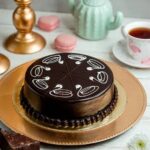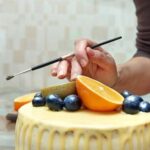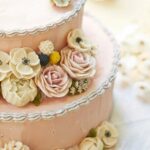Flowers are an essential element in the art of cake decorating, adding a touch of natural beauty and elegance to any cake design. Whether you’re creating a romantic wedding cake or a whimsical birthday cake, incorporating flowers can greatly enhance the overall aesthetic and theme of your creation.
In this article, we will explore the importance of adding flowers to cake designs, as well as provide a brief overview of the different types of flowers commonly used in cake decorating.
When it comes to cake decorating, flowers have the power to elevate a simple design into something truly extraordinary. They bring life and color to cakes, creating focal points that draw attention and captivate guests. Not only do they add visual appeal, but they also add depth and dimension to your cakes. From delicate roses to vibrant daisies and lilies, the possibilities with floral decorations are endless.
Before delving into the art of making flowers for cake decorating, it is important to gather the necessary tools and materials. In the following sections of this article, we will discuss essential tools like gum paste, flower cutters, veiners, foam pads, and ball tools.
We will also recommend brands and provide guidance on where to purchase these materials. Additionally, we’ll share tips on setting up a dedicated workspace for cake flower making to ensure efficient organization and ease during the creative process.
To successfully incorporate flower decorations into your cakes, it is crucial to choose the perfect flower design for each specific cake style. Different flower designs evoke various moods – from romance to modernity – which must harmonize with your overall cake theme and color scheme. We will provide inspiration sources for finding unique flower designs and ideas that perfectly complement your vision.
In summary, adding flowers to your cake creations is an essential part of cake decorating that can transform ordinary cakes into stunning works of edible art. Stay tuned for insights on gathering tools, choosing ideal flower designs, working with gum paste: shaping petals creatively, assembling and arranging flowers on your cakes, pro tips for elevating your flower decorations, and caring for and preserving your exquisite cake flowers.
It’s time to bring a touch of nature’s beauty to your next homemade masterpiece.
Gathering the Necessary Tools and Materials
To successfully make flowers for cake decorating, it is important to gather the necessary tools and materials. Ensuring you have the right supplies will not only make the process smoother but also help you achieve more professional-looking results. Here is a list of essential tools required for making flowers for cake decorating:
- Gum paste: This special type of sugar paste is ideal for creating realistic and edible flower decorations. It can be rolled out thin, dries quickly, and holds its shape well.
- Flower cutters: These metal or plastic cutters come in various shapes and sizes to create different types of flower petals. They allow you to easily cut out consistent shapes for your flowers.
- Veiners: Veiners are used to add texture and detail to flower petals by imprinting patterns onto gum paste. They come in different designs and can really enhance the realism of your flowers.
- Foam pad: A foam pad provides a soft surface for shaping and thinning gum paste petals using a ball tool or other shaping tools. It helps give the petals a natural curve and adds dimension.
- Ball tool: This tool has a rounded end that allows you to thin and shape the edges of flower petals by applying gentle pressure. It is especially useful for creating lifelike ruffling effects.
When gathering these tools, it is helpful to do some research on trusted brands that offer high-quality products suitable for cake decorating. Some popular brands include Wilton, PME, FMM, and JEM. These brands are readily available at specialty baking stores or online retailers like Amazon or baking supply websites.
In addition to the necessary tools, it’s important to set up a dedicated workspace specifically for making cake flowers. Having an organized space with ample lighting will make it easier to work efficiently and with precision. Consider using a non-stick mat or parchment paper on your work surface to prevent sticking, as well as small containers or jars to hold your tools and materials.
By gathering the necessary tools and setting up a dedicated workspace, you will be well-prepared to embark on your cake flower making journey. With the right supplies at hand, you can now move on to choosing the perfect flower design for your cake.
Choosing the Perfect Flower Design for Your Cake
When it comes to cake decorating, flowers play a crucial role in enhancing the overall aesthetic and theme of a cake. The right choice of flowers can transform a plain cake into an exquisite masterpiece. In this section, we will explore the process of selecting the perfect flower design for your cake.
Examining different flower designs and their suitability for various cake styles is essential in creating a cohesive look. For example, romantic cakes often feature delicate and soft flower designs such as roses or peonies. On the other hand, whimsical cakes lend themselves well to playful and vibrant flowers like daisies or sunflowers. Modern cakes, with their clean lines and minimalistic style, often pair well with bold and structural floral designs such as orchids or calla lilies.
Considerations for matching the flower design with the cake’s theme and color scheme are also important. It is essential to ensure that the flowers complement the overall design without overpowering it. For instance, if your cake has a rustic theme with earthy tones, you may opt for wildflowers or lavender sprigs to maintain a cohesive look. If your cake features pastel colors, delicate and light-colored flowers like cherry blossoms or hydrangeas can add an elegant touch.
Finding inspiration sources for unique flower designs is key to creating one-of-a-kind cakes. You can browse through floral magazines, visit local gardens or flower shops to get ideas for different flower species and arrangements. Additionally, social media platforms like Pinterest and Instagram are treasure troves of inspiring floral designs from talented bakers all over the world.
By carefully choosing flowers that complement your cake’s style, color palette, and theme, you can create stunning masterpieces that impress both visually and taste-wise.
Sub-section: Tips for Choosing Artificial Flowers
If fresh flowers are not available or suitable for your cake decoration needs (such as when they are toxic or not in season), artificial flowers can be an excellent alternative. When selecting artificial flowers, choose high-quality ones that are specifically designed for cake decorating. These flowers should be made from food-safe materials and be free from chemicals or dyes that can contaminate the cake.
When working with artificial flowers, it is crucial to note that some colors may bleed when they come into contact with buttercream or fondant. To prevent this, lightly dust the flowers with cornstarch or confectioners’ sugar to absorb excess moisture before placing them on the cake.
Remember to consider the overall style and theme of your cake when choosing artificial flowers. Opt for realistic-looking options that closely resemble their fresh counterparts for a more polished and professional appearance.
Sub-section: Incorporating Fresh Flowers
For those who prefer real blossoms on their cakes, it is essential to ensure their safety and compatibility with the cake’s design. Not all flowers are safe for consumption, so it is vital to research which types of blooms are edible or non-toxic before using them for cake decoration.
When using fresh flowers on your cake, always wash them thoroughly and remove any leaves or stems before placing them on the cake. This prevents the sap from seeping onto the icing. It is also recommended to place a small piece of parchment paper or plastic wrap between the flower stems and the cake to avoid direct contact.
Fresh flowers can add a beautiful touch to your cake, but it is important to remember that they have a limited lifespan once cut from their source. Use them sparingly and only add fresh flowers right before serving to maintain their freshness and appearance.
Choosing the perfect flower design for your cake involves careful consideration of various factors such as style, theme, color scheme, and availability of fresh or artificial options. By exploring different designs suitable for your specific needs and seeking inspiration from various sources, you can create a visually stunning cake that is sure to impress.
Working with Gum Paste
Gum paste is a versatile and popular medium for creating lifelike flower decorations for cakes. With its pliability and ability to hold intricate shapes, gum paste allows cake decorators to achieve stunning and realistic floral designs that enhance the overall aesthetic of a cake. In this section, we will provide a step-by-step guide on working with gum paste to create beautiful flowers for cake decorating.
Firstly, it is important to understand what gum paste is and how it differs from other mediums like fondant or modeling chocolate. Gum paste is made from a combination of confectioners’ sugar, water, and edible gums such as tylose or CMC powder.
It has a firmer consistency than fondant but remains soft and easy to work with. The benefit of using gum paste is that it dries quickly, allowing the flowers to hold their shape without sagging or losing their defined edges.
To begin working with gum paste, start by kneading it until it becomes soft and pliable. This helps to activate the gums in the paste and ensures that all ingredients are well incorporated. It’s essential to work on a clean surface dusted with cornstarch or powdered sugar to prevent sticking. Once the gum paste is ready, cover it with plastic wrap or place it in an airtight container to prevent drying out while you work on individual flower components.
When shaping flower petals with gum paste, there are different techniques you can use depending on the type of flower you are creating. For example, for roses, roll out gum paste into thin sheets and use petal cutters in various sizes to cut out individual petals.
Use a ball tool to thin the edges of each petal and create natural curves. For daisies or lilies, flatten small balls of gum paste into discs and use veining tools or toothpicks to add texture and details.
To achieve realistic colors for your gum paste flowers, consider using gel or powdered food coloring. These types of colorants provide vibrant shades without adding excess moisture to the gum paste. Start with a small amount and gradually add more until you reach the desired hue. Remember to knead the colored gum paste thoroughly to ensure an even distribution of color.
Working with gum paste requires precision and patience, but with practice, you can create stunning flower decorations for your cakes. In the next section, we will delve into creating lifelike flower petals and shapes using gum paste, providing step-by-step tutorials for popular flowers like roses, daisies, and lilies.
Creating Lifelike Flower Petals and Shapes
One of the key aspects of making flowers for cake decorating is creating lifelike petals and shapes. Whether you’re aiming for a rose, daisy, lily, or any other type of flower, having realistic texture and dimension can really elevate the overall look of your cake.
In this section, we will provide step-by-step instructions on shaping different types of flower petals using gum paste, as well as share some tips and tricks to help you achieve professional-looking results.
To start, it’s important to properly prepare your gum paste before shaping the petals. Knead the gum paste until it is soft and pliable, but be careful not to overwork it as this can cause the gum paste to dry out. Roll out the gum paste to your desired thickness using a rolling pin. A thickness of about 1/8 inch (3 mm) is generally recommended for flower petals.
Once you have rolled out the gum paste, use flower cutters or templates to cut out the shapes for your petals. Ensure that you have a clean cut by pressing firmly and evenly but avoid twisting or dragging the cutter. If necessary, use a foam pad underneath the gum paste when cutting to create depth and shape.
After cutting out the petals, use a ball tool or your fingers to thin and shape each petal individually. This can be done by gently pressing down on the edges of the petal while leaving the center thicker. To create a more natural appearance, you can also cup or curl some of the petals by placing them on a curved surface such as an overturned spoon or a foam pad with veining textures.
Texture is key in achieving lifelike flower petals. You can add realistic veining by using a veiner tool or by gently pressing a textured mat onto each petal. For example, for roses, using a cone-shaped veiner will create beautiful creases that mimic the natural folds of rose petals. Experiment with different tools and techniques to create unique textures and dimensions for each type of flower.
To give your flower petals a delicate and soft look, you can also add ruffles or frills to the edges. This can be done by using a ball tool or a toothpick to gently press small indentations into the edges of the petals. This technique works especially well for flowers like peonies or carnations.
Once you have shaped all your petals, let them dry completely before assembling your flowers. This is usually done by placing them on a foam pad or drying rack in a cool, dry place for several hours or overnight. Drying time may vary depending on the thickness of the gum paste and humidity levels in your environment, so it’s important to be patient and allow enough time for the petals to fully set.
Creating lifelike flower petals and shapes takes practice, but with patience and attention to detail, you can achieve stunning results. Don’t be afraid to experiment with different techniques and designs to add your own personal touch to your cake decorations.
| Tool | Description |
|---|---|
| Flower cutters | Used to cut out shapes for flower petals |
| Veiner tool | Creates veining texture on flower petals |
| Foam pad | Provides support and depth when shaping petals |
| Ball tool | Used for thinning, shaping, and adding ruffles to petal edges |
Assembling and Arranging the Flowers on Your Cake
Techniques for Attaching Flower Decorations
Once you have created your beautiful gum paste flowers, it is time to attach them securely to your cake. There are a few different methods you can use depending on the type of flower and the desired effect. One common technique is to use royal icing as an edible adhesive. You can apply small dots or thin lines of royal icing to the back of each flower and gently press it onto the cake.
Another method is to use floral wire or toothpicks as supports for larger or heavier flowers. Simply insert the wire or toothpick into the base of the flower before it dries completely, and then insert the other end into the cake. This will ensure that your flowers stay in place throughout transportation and serving.
Guidelines for Arranging Flowers
Arranging your flowers in a visually pleasing and balanced manner is crucial for creating an impressive cake design. Consider using odd numbers of flowers rather than even, as odd numbers tend to create a more aesthetically pleasing arrangement. Start by placing one or two focal point flowers on your cake, such as large roses or lilies, and then build around them with smaller filler flowers.
You should also consider the height and width of each flower when arranging them on your cake. Varying heights and angles can add depth and dimension to your design. Experiment with different placements until you achieve a visually balanced composition.
Incorporating Other Edible Elements
To complement your gum paste flowers, consider adding other edible elements such as leaves, vines, or edible pearls. These additional elements can enhance the overall design and create a more cohesive look. To make leaves, simply roll out green gum paste and cut out leaf shapes using leaf cutters. Attach these leaves around your flowers using royal icing or by inserting them directly into the sides of the cake.
Alternatively, you can create delicate vines by rolling thin ropes of green gum paste and gently bending them to imitate the natural curve of a vine. Attach these vines to the cake around your flowers using royal icing or by inserting them into the cake.
By incorporating these additional edible elements, you can create a stunning and professional-looking cake that is sure to impress your guests. Remember to experiment with different arrangements and have fun with your design.
Pro Tips for Taking Your Flower-Decorated Cakes to the Next Level
Creating flower-decorated cakes is a wonderful way to showcase your creativity and add a touch of elegance to any special occasion. Here, we provide some pro tips to help you take your flower-decorated cakes to the next level:
Adding Unique Touches
To make your flower decorations stand out, consider adding unique touches that reflect your personal style and the theme of the occasion. You can incorporate elements such as edible glitter or shimmer dust to give your flowers a magical sparkle. Another idea is to use edible gold or silver leaf on select petals or centers of the flowers for an opulent look.
Advanced Techniques
Once you have mastered the basic techniques, you can take your flower decorations to a whole new level by trying advanced techniques such as airbrushing or hand-painting. Airbrushing allows you to achieve smooth gradients and shading effects on your flowers, creating depth and realism. Hand-painting, on the other hand, gives you greater control over intricate details and allows you to customize colors and designs.
Troubleshooting Common Challenges
As with any art form, cake flower making comes with its own set of challenges. Some common issues include petals cracking, gum paste drying too quickly or becoming sticky, or difficulties in attaching flowers securely to the cake. To overcome these challenges:
- Cracking petals can be prevented by properly kneading the gum paste and keeping it well hydrated.
- To avoid dryness or stickiness in gum paste, store unused portions wrapped tightly in plastic wrap and place it in an airtight container.
- For securely attaching flowers, use toothpicks or floral wire inserted into the base of the flower before placing it on the cake.
By following these pro tips, you can elevate your flower-decorated cakes, making them even more visually stunning and personalized. Remember to have fun and experiment with different techniques to create unique and beautiful flower designs that will impress your friends and family.
Caring for and Preserving Your Cake Flowers
Preserving and caring for your cake flowers is an important step to ensure that your beautiful creations stay fresh and vibrant for as long as possible. With proper care, you can not only extend the lifespan of your gum paste flowers but also repurpose them for future cake decorating projects or use them as standalone artistic creations.
To store gum paste flowers, it is essential to keep them in a cool, dry place away from direct sunlight. Excessive heat or humidity can cause the flowers to wilt or lose their shape. To protect delicate petals and intricate details, it is recommended to place the flowers in a sturdy container with a lid or cover them loosely with plastic wrap. This will prevent dust particles and other contaminants from settling on the petals.
If you have leftover or extra gum paste flowers that were not used in your cake design, do not let them go to waste. These flowers can be repurposed and transformed into stunning standalone art pieces or used in other creative projects. One idea is to attach floral wire stems to the flowers and arrange them in a vase filled with floral foam. This creates a unique and visually appealing centerpiece for any occasion.
Additionally, maintaining the freshness and appearance of flower decorations on cakes requires some extra care. To avoid any potential damage during transportation or storage, it is recommended to handle decorated cakes with care. When storing cakes with gum paste flowers, it is best to refrigerate them but ensure they are properly covered to prevent condensation from affecting the appearance of the flowers.
In conclusion, by following these tips for caring and preserving your cake flowers, you can enjoy their beauty for longer periods of time while also exploring different ways to repurpose them. Whether you choose to incorporate these preserved gems into future cake designs or display them as standalone artistic creations, you’ll be able to appreciate the hard work and creativity that went into making these lifelike gum paste flowers.
Frequently Asked Questions
How to make decorative flowers for a cake?
Making decorative flowers for a cake can be a fun and creative process. One way to make these flowers is to use gum paste or fondant, which are easily moldable and can be shaped into intricate designs. Start by rolling out the gum paste or fondant to a thin, even layer. Then, using flower-shaped cutters or freehand techniques, cut out flower shapes from the rolled out paste.
Next, gently shape each petal using your fingers or specialized tools to create depth and texture. Allow the flowers to dry completely before attaching them to the cake with edible glue or royal icing. To add color, you can dust the flowers with edible powder or paint them with food coloring diluted in vodka.
How do you make easy edible flowers for cakes?
If you’re looking for easy edible flowers to decorate your cakes, one option is to use fresh flowers that are safe for consumption. Make sure you choose organic flowers that haven’t been treated with any harmful chemicals.
Prioritize selecting edible flowers like pansies, violets, marigolds, and daisies that are commonly used in culinary applications. Simply wash the flowers thoroughly under cold water and gently pat them dry before placing them on top of the cake as an elegant and natural decoration.
How to make royal icing flowers for beginners?
Making royal icing flowers can be a great project for beginners who want to add intricate details to their cakes. To get started, prepare a batch of royal icing by whisking together egg whites (or meringue powder) with powdered sugar until stiff peaks form. Transfer the icing into piping bags fitted with various tips appropriate for creating flower shapes such as roses or lilies.
Practice piping different petals onto parchment paper until you feel comfortable with your technique before moving on to decorating your cake directly. Remember that consistency is key; if the icing is too runny, it won’t hold its shape but if it’s too stiff it’ll be difficult to pipe smoothly. With patience and practice, beginners can create beautiful royal icing flowers to add an elegant touch to their cakes.

Welcome to my blog about home and family. This blog is a place where I will share my thoughts, ideas, and experiences related to these important topics. I am a stay-at-home mom with two young children. I hope you enjoy reading it! and may find some helpful tips and ideas that will make your home and family life even better!





